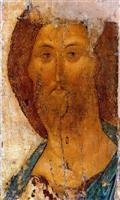 Before the Word came into the world
Before the Word came into the worldThe sages sought Him out in every place.
They saw Him not, but sensed His presence everywhere.
They found Him in living beings,
in mountain crags and
Flowing streams, in seas and winds.
He was not these things.
But He spoke in these things, guiding them.
All things followed His Course.
Therefore the sages called Him also
by His other name:
The Way (Tao),
The Course that all things are to follow.
The trees, the birds, the rivers and winds:
These had no choice;
Man alone is given choice;
Man alone can follow or go his own way.
If he follows the Way, he will suffer with the pain of the world,
But He will find the Original Harmony.
If he follows his own way, he will suffer only with himself,
And within him will be chaos.
- Christ the Eternal Tao, The Second Ennead, “The Coming of the Way,” Chapter 10.
Hieromonk Damascene explains the Orthodox Christian view of ancient religions evident in Christ the Eternal Tao and in his approach to the Tao Teh Ching:
“Religious syncretism, in its modern forms, regards all paths as possessing equal truth simultaneously, and in so doing is forced to overlook certain basic distinctions, or to offer complicated explanations in order to rationalize these distinctions away. The ancient Christian teachers, on the other hand, took a more honest and discerning approach, which in the end proved to be more simple, natural, and organic. Rather than mixing all the religions together like the moderns do, these ancients understood that there was an unfolding of wisdom throughout the ages. They saw foreshadowings, glimpses and prophecies of Christ not only among the ancient Hebrews, but also among other people who lived before Him, and they saw the writings of pre-Christian sages as a preparation for Christ as the apogee of revelation.” (P.40)
“Avoiding the common pitfalls of religious syncretism, Christ the Eternal Tao shows Lao Tzu’s Tao Teh Ching as a foreshadowing of what would be revealed by Christ, and Lao Tzu himself as a Far-Eastern prophet of the Incarnate God.”
All passages are from Christ the Eternal Tao by Hieromonk Damascene, Valaam Books, 1999. The book is available from St. Herman Press. The icon of Christ shown here was written by Andre Rublev. The icon is in the public domain.
